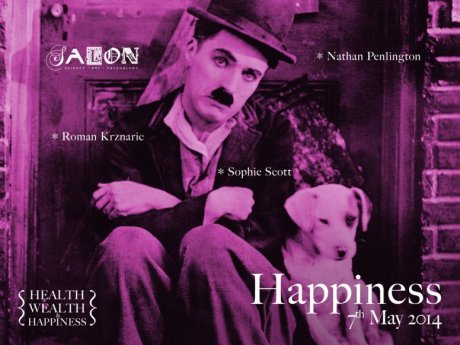I’ve been knee-deep in a massive writing project recently, which means I’ve not had much time for writing articles. However, I did manage to throw these three together…
Talking to a therapist, going for a run and practising mindfulness meditation are all well-established ways to deal with emotional trauma. However, these three practices typically exist in isolation from each other. Someone dealing with emotional pain might see a therapist to talk about the relationships in their life, go to the gym to exercise their body, and download a podcast on meditation.
Psychotherapist William Pullen has developed a new form of therapy entitled Dynamic Running Therapy to fuse these practices together. He has published a book called Run for your Life to explain this new method. I spoke to William to find out more…
Kate: What exactly is Dynamic Running Therapy?
William: DRT is a fusion of mindfulness, running and regular talk therapy. Like most therapy it is open-ended: there is no set limit on how long the therapy will last. One of the things I try to avoid in my work is striving – I think there is already so much of that in the world. With DRT, we see what happens and when it happens. The practice is client-led: they decide when to run or sit or walk. This is important as the body is highly informative: it can tell us about what’s going on deep inside. I look out for changes in movement such as acceleration or slowing down. Sometimes a client’s stance helps me to see how they address the world or a particular topic.
Kate: Who would benefit from this kind of therapy?
William: DRT can be great for people suffering from depression, a debilitating condition that can be very difficult to shift. The client often feels helpless and angry. Taking proactive action, through running and so on, helps the patient to feel more in control. Clients with anxiety can benefit a great deal from the mindfulness aspect of the therapy: again, it is an opportunity to take proactive steps to manage their condition. Clients with eating disorders should speak to their doctor before embarking on DRT, as the exercise programme may not be appropriate.
Kate: Why should someone with depression or anxiety try DRT rather than simply talking to a therapist?
William: Because DRT uses the body, a greater sense of commitment and progress is often experienced. There is a strong sense of both engagement and progress. Of course the office and the park offer different benefits, and then there are the peculiarities of the client to take account for. DRT isn’t for everyone, but in my experience DRT is more engaging – the movement involves greater investment and has a more identifiable sense of accomplishment. But as ever, its all down to what the client is comfortable with.
Kate: Tell me about your book – is it designed to be used alongside therapy? Or can it replace therapy? (I’m aware that many people can’t afford to see a therapist.)
William: “Run for your Life” is not for use alongside a talking therapy. The book offers programmes for various conditions, including a programme for running with your kids and getting closer to them, and ideas for establishing a mindful running or walking practice.
For someone with a common mental health condition, DRT is an excellent choice – it’s very practical and you can do it anywhere. It’s also a great way to establish a mindful running or walking practice, which offers a myriad of health benefits and can be continued once the patient has recovered from their condition. Mindful running is enjoyable and can be a lifelong practice, not just a short-term solution for someone dealing with a crisis.
I’ve been neglecting my blog in recent months for a number of reasons, so I thought I’d publish links to some pieces I’ve written recently. I then realised I’ve written exclusively about the housing shortage and care homes.
Admittedly, these are not the most dazzling stories to brighten up a dreary February evening. However, in policy terms these are absolutely crucial issues. They’re the issues that the Conservative government doesn’t want you to research, because they don’t want you to know about their appalling track record in managing housing and health policy.
Could better housing policy improve our health and wellbeing?
What contribution can volunteers make to improving quality outcomes in care homes?
Last time buyers: who can we fix the shortage of specialist retirement housing?
http://www.citymetric.com/fabric/last-time-buyers-britain-needs-more-retirement-housing-too-1783
Enjoy. I’m going to write about my adventures in Sri Lanka next month.
So it’s been a while since I updated this blog…I was going to apologise but then decided against it. There’s something to be said for turning the volume down on the constant stream of online news and social media updates.
So with this in mind, I intend to get slightly more efficient at publishing blog posts, but not much more!
In the meantime, here’s some recent work I’ve had published in the Guardian and elsewhere…
Review of the Mill House Retreat Centre in Normandy where I attended a yoga and qi gong retreat with Mimi Kuo-Deemer:
http://queenofretreats.com/mill-retreat-centre-review/
An investigation into the effectiveness of mindfulness therapy as a clinical treatment for mental health patients:
http://www.theguardian.com/healthcare-network/2015/may/14/mindfulness-mental-health-treatment-nhs
A closer look at the progress Health and Wellbeing Boards have made (and obstacles they have faced) in enhancing the wellbeing of local populations across the UK:
http://www.theguardian.com/healthcare-network/2015/feb/13/health-and-wellbeing-boards-bigger-role
Review of wellbeing-focused career change book by management coach Gill Coombes:
http://queenofretreats.com/hearing-our-calling-review/
Happy reading!
In May 2014, the Mindfulness All-Party Parliamentary Group began its eight month inquiry into the potential for mindfulness training in key areas of public life: health, education, the workplace and the criminal justice system. The full report will be published in June 2015, but today sees the launch of the interim report at the Houses of Parliament.

Houses of Parliament: image by Jon Adair
The interim report, Mindful Nation UK, urges all political parties to consider a series of recommendations for inclusion in their manifestos for the 2015 General Election. These recommendations include:
- Widening access to mindfulness-based interventions (such as MBCT or MBSR) for people with long-term health conditions.
- Access to MBCT should be substantially widened for adults with a history of depression.
- More mindfulness pilot projects linked to good evaluation and research should be set up.
- Mindfulness in schools should be made a priority for development and research.
- Bodies such as Public Health England should work with public health teams and Child and Adolescent Mental Health Services (CAMHS) to promote mindfulness-based programmes in schools.
- Public sector employers such as the NHS and civil service should pioneer good practice and set up mindfulness pilot projects, which can be evaluated as part of their responsibility to combat stress.
The Mindfulness APPG is co-chaired by MPs from all the major parties: Chris Ruane (labour), Tracey Crouch (conservative) and Lorely Burt (liberal democrat). The interim report describes mindfulness as a “transformative practice, leading to a deeper understanding of how to respond to situations wisely,” and urges government to widen access to mindfulness training in key public services, where it has the potential to be “an effective low-cost intervention with a wide range of benefits.”
The Mindfulness Initiative, a collaboration of the main mindfulness training and research centres of Oxford, Exeter and Bangor Universities as well as the Sussex Partnership NHS Foundation Trust and the Mental Health Foundation, are leading the inquiry.
Chief Executive of the Mental Health Foundation, Jenny Edwards CBE, said: “We have been advocating the benefits of mindfulness through our Be Mindful campaign since 2010, providing online courses for individuals and companies…we now want 2015 to be the year of mindfulness, and are delighted to formally join the Mindfulness Initiative in translating those benefits more specifically into policy recommendations.”
This is all excellent news. Thousands of peer-reviewed scientific papers show that mindfulness enhances mental and physical wellbeing and reduces chronic pain, and as this report states it is an effective low-cost intervention that can improve wellbeing and productivity across many areas of public life, including health, education, the workplace and the criminal justice system.
It’s great to see that the mindfulness APPG is co-chaired by representatives from all the major political parties, but time will tell whether that grows into genuine support for mindfulness within the three parties in terms of resource allocation. I’ll be keeping an eye on the election manifestos to see which of the parties takes these recommendations on board!
This week is ‘Live like a Stoic’ week in London. But what does it mean to be stoical? Doesn’t it involve being miserable and repressing your emotions? No no no. Jules Evans, Policy Director at the Queen Mary Centre for the History of Emotions, explained to me what Stoicism is, how it can benefit busy Londoners, and how it relates to mindfulness meditation.
KB: What is Stoicism?
JE: It’s an ancient philosophy that originated in Athens in 300 BC before spreading to Rome and around the world. It inspired Cognitive Behavioural Therapy and still helps many people today to cope with adversity and live a good life.
KB: How can adopting a stoical outlook on life help busy Londoners cope with the demands of living in a chaotic, capitalist and at times dangerous city?
JE: It helps people focus on what is in their control while accepting what is not. It helps them become aware of how their opinions and perspective can create their emotions and how they can change their perspective and thereby change their emotions. And it helps them think about virtue – what does it mean to live with fortitude, patience, kindness, integrity?
KB: Can Stoicism help Londoners to observe the beauty in their own city?
JE: There’s an idea in Stoicism of living in the now, bringing your attention to the present in order to appreciate the beauty of nature for example. There’s also the idea of sometimes widening your perspective, getting a bigger picture, through the contemplation of nature. That might best happen outside of London, but I find Hampstead Heath a good place for contemplation!
KB: Would a stoic practice mindfulness meditation?
JE: Yes many do. Both Stoicism and Buddhism share the idea of the importance of mindfulness, of learning to be conscious of one’s automatic thoughts and desires and to avoid hasty attachment or aversion to external things.
KB: What does Stoicism have in common with Buddhism?
JE: Well, mindfulness for one. Overcoming attachment and aversion. Focusing on the present moment. More fundamentally, both think of philosophy as a form of therapy or medicine. And both share the cognitive theory of the emotions – the idea our emotions are connected to our thoughts and beliefs.
KB: Where can Londoners go to practice Stoicism and meet other stoics?
JE: We are hosting a big event in London this Saturday although it’s sold out alas. But there is an online handbook at http://modernstoicism.com/ which people can follow. Plus lively facebook and reddit pages on Stoicism, and an organisation called New Stoa. There are many local philosophy groups such as the London Philosophy Club, and organisations like the School of Life and the Idler Academy often host stoic events.
When I worked in London I used to pass through Baker Street tube station every morning. This war memorial always caught my attention.
What does this have to do with mindfulness? Quite a lot I think. Clinical mindfulness expert Jon Kabat-Zinn explained at the ‘Becoming Conscious: the Science of Mindfulness’ conference that mindfulness is: “paying attention, on purpose, in the present moment, non judgementally”.
Reading the names of these soldiers on the stone plaque who, ‘left all that was dear to them, endured hardness, faced danger, and finally passed out of sight…giving up their own lives that others might live in freedom,’ always had the immediate impact of focusing my attention on the present moment. It’s easy to be negative about public transport in London: it’s over-priced, people are rude, it’s not clean enough, there’s never a seat…the list of complaints is endless. Taking a moment to read this plaque every morning reminded me to be grateful that our country is not at war, and that my friends and family are healthy.
I would normally stand in front of this plaque for a minute or two before catching the eastbound circle line train to euston square. I would then rush to the office and begin multi-tasking until the end of the day, but those two minutes were important.
It’s not easy to find stillness when you’re travelling through London, particularly in rush hour, but if you look hard enough then opportunities like this are dotted all over the city. The key is to stop inwardly complaining, stop rushing, stop checking your phone for a moment and look around – for me this plaque was a daily reminder to be present and grateful.
Earlier this month I went to a talk by Roman Krzanaric, one of three talks on ‘health, wealth and happiness’ held by Salon London at the Adam Street club, just off the Strand.
Roman told us all about the six habits of highly empathic people, and how empathy, “the imaginative act of stepping into the shoes of another person and viewing the world from their perspective“, is not only a good (in the moral sense) thing to do, but it is also good for you. Roman argues that practising empathy will improve your relationships with your friends, partners, family, colleagues (even your enemies!) and enhance your understanding and appreciation of the world around you.
Empathy and social connection are also good for your health: Professor John Cacioppo, a psychologist at the University of Chicago, observed dramatic differences in the rate of decline in physical and mental health as people age, and found that these differences can be linked to the quality of the individual’s personal relationships. Loneliness can even shorten life expectancy.
Before I go any further I should explain that empathy is very different from sympathy. Sympathy is the recognition that someone else is in a bad place, but it stops far short of what Roman describes as the ‘imaginative leap’ required to empathise and really step into the shoes of another person and understand their concerns, their challenges and their vulnerabilities. Research professor and best-selling author Dr. Brene Brown created this fantastic three minute ‘RSA Short’ animation to explain the difference between sympathy and empathy.
Roman urged us to start cultivating curiosity about strangers, and to use this curiosity to challenge our prejudices and better understand the uniqueness of individual experience. For example, in London a lot of people work in financial services, and suffer under the stereotype of ‘greedy banker’, a hangover from the post-credit crunch blame mentality. The mainstream media created a stereotype of bankers as a ruthless, amoral group, cut off from society with no concern other than their own self-interest. But this is an unlikely, ‘panto baddie’ style evaluation of a career path that attracts a wide range of personalities, from the deeply conscientious and socially responsible, through to the ‘selfish capitalist’ stereotype. In order to understand and empathise with someone, we need to strip away any pre-concieved notions and observe that person as a unique and complex individual.
Roman encouraged us to become more empathic through practising the art of conversation, and becoming more sensitive listeners. He also gave some beautiful examples of ‘grassroots’ empathy projects from around the world, including an initiative called ‘Hello Peace’, set up to facilitate empathy between Israelis and Palestinians who are affected by conflicts over land and resources in the middle east. A free telephone line connects Israelis and Palestinians who want to talk about ‘reconciliation, tolerance and peace’. In its first five years the project logged more than a million calls.
Roman argues that empathy is an integral part of human nature, and speaks fluently about the evidence from evolutionary biology and neuroscience that supports this claim. His book Empathy Revolution draws on ten years of research into this subject, and calls on us to practice empathy in our daily lives in order to defeat prejudice and bring about positive social change in our communities (and beyond). He has also created an amazing Empathy Library, where people can post recommendations and read reviews about books and films that help us to empathise with people from different backgrounds and gain a greater understanding of the world through their perspectives.
So how does all of this relate to mindfulness? Professor Paul Gilbert OBE explains in his latest book Mindful Compassion that ‘compassion’, comes from the Latin word ‘compati’, meaning ‘to suffer with’. This has very clear parallels with how Roman Krznaric and Brene Brown define empathy. Paul Gilbert argues in Mindful Compassion that in order to cultivate compassion we must first practice mindfulness. Paul writes: “we need to be aware of where our mind habitually goes and learn to direct our faculty of attention in ways that serve us. This is the role of mindfulness in the context of compassion training.”
Researchers have also observed a greater ability to adopt other people’s perspective and manage stress by people who practice mindfulness-based stress reduction (MBSR) techniques.
While this data is useful, I think it brings to light something that we all know in our hearts: practising mindfulness makes us calm, happy and grounded, and this is a perfect environment for compassionate and empathic behaviour. It makes you happy, and it makes those around you happy: it’s a win-win situation!
Strawberries, chocolate or crisps? This was the choice I was given when I attended an ‘Introduction to Mindful Eating’ class at The Mindfulness Project, a new organisation dedicated to teaching secular mindfulness practices to as many Londoners as possible.
In the UK, we’re not great at eating mindfully. A 2012 survey found that 26% of adults in England are obese, and the National Obesity Forum say a recent prediction that half the UK population will be obese by 2050 ‘underestimates the scale of the problem’. King’s College London and the UCL Institute of Child Health found that the number of people being diagnosed with eating disorders increased by 15% between 2000 and 2009.
Something has gone really wrong. Or rather, several things have gone wrong. The most popular solutions focus on changing what we eat. We are told to eat less sugar, caffeine, gluten and saturated fats, eat more healthy fats, more fruit and veg, drink less alcohol and so on. It’s very common to open a mainstream newspaper or magazine and receive advice on what we should and shouldn’t be eating. It’s pretty rare to find advice on how we should be eating, or why the popular solutions don’t really work for a lot of people. We’re told that we must improve our diets, but we’re not really taught exactly how we should carry this out in practice.
This is a real shame because, as Dr. Cinzia Pezzolesi taught us on Tuesday night in the beautiful second floor studio at 6 Fitzroy Square, learning how to eat mindfully can revolutionise your entire relationship with food. Once you learn how to really engage all your senses when you eat, and tune into the feedback your body gives you about your appetite, it becomes much easier to make good food choices, and to know when your body has had enough.
Instead of immediately reacting to the stimulus of a real (or misinterpreted) hunger cue, we can mindfully sit with the sensation of hunger and make a conscious decision about how best to respond to that stimulus. Mindfulness puts us back in the driving seat, and enables us to identify and become familiar with what is often an underlying emotional trigger that presents itself as a hunger cue. It also forces us to stop multi-tasking: by slowing down and bringing our full awareness to our food we can notice the enormous difference between a nourishing meal and an empty snack.
Dr. Pezzolesi also reminded us to be really conscious of our inner monologue when it comes to food and body image. Most people are way too hard on themselves when it comes to making bad food choices. We should develop a more compassionate approach to our eating habits, underpinned by an appreciation of how our food choices don’t happen in isolation, rather they are woven into: a) our practical daily lives with limitations such as availability of healthy food, restrictions on the time and space needed to eat mindfully, the temptation of ‘bad’ food choices, ingrained habits, etc. and b) our emotional lives – the ebb and flow of our emotions can draw us towards good and bad food choices in a way that is quite separate from physical hunger.
Dr. Pezzolesi also described something called the ‘abstinence violation effect’ – a key issue in overeating. If we tell ourselves that we must not eat something (i.e. impose abstinence), the temptation to eat it becomes greater. We are then likely to violate this rule, feel like a failure for doing so, and then potentially go on to eat more of the ‘forbidden food’ than we would have if we had not tried to impose a rule in the first place. A lose-lose situation!
In contrast, mindful eating is win-win. You can eat any food you like, providing you do so with complete awareness, and an attitude of self-compassion. Once you start eating more mindfully, the desire to eat unhealthy food starts to diminish, as you become more in touch with what your body really needs. So you make better choices, and you gain more pleasure from eating, therefore it’s a win-win!
In addition to Dr. Pezzolesi’s talk we did a short mindful breathing exercise, and a mindful eating exercise. As I mentioned, I decided to pick the strawberry option. The chocolate did look tempting, but I’d already had a nice piece of carrot cake that day 🙂
The Mindfulness Project are running a range of classes and courses throughout April and May, including some free taster sessions and movie screenings. I’d definitely recommend trying one of the taster sessions and having a chat to the project’s founders Autumn and Alexandra – they are very approachable ladies and super passionate and knowledgeable about mindfulness. I’m sure they’d be delighted to advise you on the best class for you!






